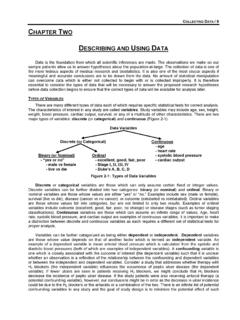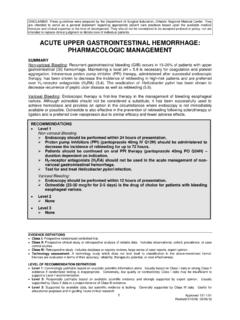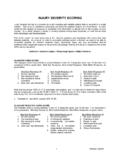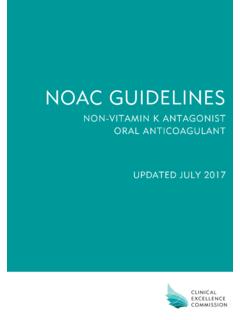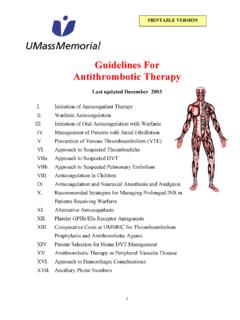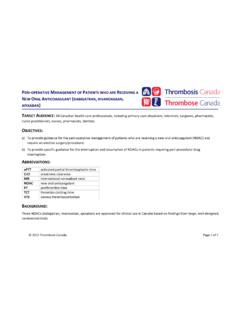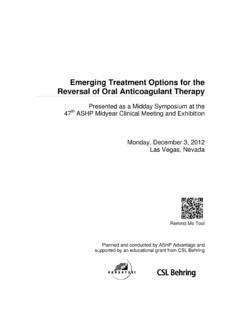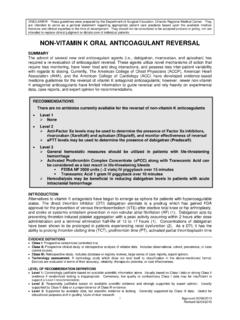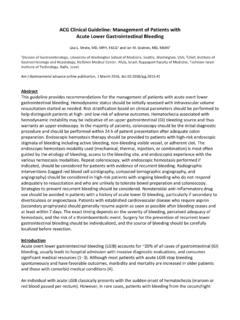Transcription of NON-VITAMIN K ORAL ANTICOAGULANT REVERSAL
1 DISCLAIMER: These guidelines were prepared by the Department of Surgical Education, Orlando Regional Medical Center. They are intended to serve as a general statement regarding appropriate patient care practices based upon the available medical literature and clinical expertise at the time of development. They should not be considered to be accepted protocol or policy, nor are intended to replace clinical judgment or dictate care of individual patients . NON-VITAMIN K oral ANTICOAGULANT REVERSAL . SUMMARY. The advent of several new oral ANTICOAGULANT agents ( , dabigatran, rivaroxaban, apixaban, and edoxaban) has required a re-evaluation of ANTICOAGULANT REVERSAL .
2 These agents utilize novel mechanisms of action that require less monitoring, have fewer food and drug interactions, and possess less inter- patient variability with regards to dosing. Currently, The American College of Chest Physicians (ACCP), American Heart Association (AHA), and the American College of Cardiology (ACC) have developed evidence-based medicine guidelines for the REVERSAL of vitamin K antagonist anticoagulants; however, newer NON-VITAMIN K antagonist anticoagulants have limited information to guide REVERSAL and rely heavily on experimental data, case reports, and expert opinion for recommendations.
3 At present time, only dabigatran has an approved agent that is specifically indicated for its REVERSAL of ANTICOAGULANT effects. RECOMMENDATIONS. Level 1. None Level 2.. patients that meet criteria for REVERSAL of dabigatran (Pradaxa ), should receive idarucizumab (Praxbind ) as a one-time intravenous dose of 5 grams Anti-Factor Xa levels may be used to determine the presence of Factor Xa inhibitors, . rivaroxaban (Xarelto ), apixaban (Eliquis ), and edoxaban (Sayvaysa ) and monitor effectiveness of REVERSAL aPTT levels may be used to determine the presence of dabigatran Level 3.
4 General hemostatic measures should be utilized in patients with life-threatening hemorrhage Criteria for REVERSAL of dabigatran with idarucizumab (must meet all): patients with a known history of dabigatran use and an elevated aPTT AND. patients with severe traumatic brain injury (TBI) or other life-threatening bleed requiring emergent surgery Due to the lack of supporting data, patients should not receive more than one dose of idarucizumab Activated Prothrombin Complex Concentrate (aPCC) along with Tranexamic Acid can be considered in patients known to be taking a Xa-inhibitor (rivaroxaban, apixaban, edoxaban) with life-threatening bleeds FEIBA NF 2000 units (~2 vials)
5 IV piggyback over 15 minutes Tranexamic Acid 1 gram IV piggyback over 10 minutes Hemodialysis may be an option for reducing dabigatran levels in non-life-threatening situations EVIDENCE DEFINITIONS. Class I: Prospective randomized controlled trial. Class II: Prospective clinical study or retrospective analysis of reliable data. Includes observational, cohort, prevalence, or case control studies. Class III: Retrospective study. Includes database or registry reviews, large series of case reports, expert opinion. Technology assessment: A technology study which does not lend itself to classification in the above-mentioned format.
6 Devices are evaluated in terms of their accuracy, reliability, therapeutic potential, or cost effectiveness. LEVEL OF RECOMMENDATION DEFINITIONS. Level 1: Convincingly justifiable based on available scientific information alone. Usually based on Class I data or strong Class II. evidence if randomized testing is inappropriate. Conversely, low quality or contradictory Class I data may be insufficient to support a Level I recommendation. Level 2: Reasonably justifiable based on available scientific evidence and strongly supported by expert opinion. Usually supported by Class II data or a preponderance of Class III evidence.
7 Level 3: Supported by available data, but scientific evidence is lacking. Generally supported by Class III data. Useful for educational purposes and in guiding future clinical research. 1 Approved 02/06/2013. Revised 02/03/2015, 03/29/2016. INTRODUCTION. Alternatives to vitamin K antagonists have begun to emerge as options for patients with hypercoagulable states. The direct thrombin inhibitor (DTI) dabigatran etexilate is a prodrug which has gained FDA. approval for the prevention of venous thromboembolism (VTE) after elective total knee or hip arthroplasty,stroke or systemic embolism prevention in non-valvular atrial fibrillation (AF), treatment of DVT or pulmonary embolism (PE) following parenteral therapy, and for prophylaxis of recurrent DVT or PE in patients who have been previously treated.
8 (1). Dabigatran acts by preventing thrombin-induced platelet aggregation with a peak activity occurring within 2 hours after dose administration and a terminal elimination half-life of 12 to 17 hours (1). Concentrations of dabigatran have been shown to be prolonged in patients experiencing renal dysfunction (2). As a DTI, it has the ability to prolong thrombin clotting time (TT), prothrombin time (PT), activated partial thromboplastin time (aPTT), and ecarin clotting time (ECT). (1). Monitoring of ANTICOAGULANT activity can be performed using PT and aPTT levels, however, the relation is nonlinear with plasma drug concentration making utilization for determination of therapeutic drug levels not feasible (1).
9 oral factor Xa inhibitors including rivaroxaban, apixiban, and edoxaban have also emerged as options requiring less monitoring and having fewer food and drug interactions than vitamin K antagonists. These agents selectively and competitively inhibit factor Xa in a reversible fashion (1,3,4). Both factor Xa inhibitors have gained FDA approved indications for the prevention of VTE after elective total knee or hip arthroplasty,prevention of stroke or systemic embolism in non-valvular atrial fibrillation, and treatment of DVT or PE. (1,3-5). Maximum factor inhibition occurred between 1 and 4 hours post-medication administration with a terminal half-life observed between 7 and 17 hours (1).
10 Challenges with these agents include undefined monitoring parameters for detection of therapeutic drug levels and no antidotes currently available for the REVERSAL of the factor Xa inhibitors. Correlations between factor Xa activity, PT prolongation, or aPTT were linear in relation to plasma drug concentrations, however variability in reagents used for assays limits applicability to clinical practice (1). The goal of this guideline is to provide recommendations for the emergent REVERSAL of oral direct thrombin inhibitors and factor Xa antagonists in patients experiencing acute emergent hemorrhage.

